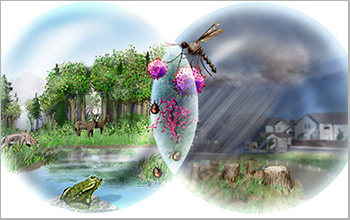Biodiversity loss increases exposure to new and established pathogens

Wildlife biodiversity is good for human health, NSF-funded scientists have found.
A growing body of evidence suggests that biodiversity loss increases exposure to both new and established zoonotic pathogens. Restoring and protecting nature is essential to preventing future pandemics.
So reports a new Proceedings of the National Academy of Sciences paper that synthesizes current understanding about how biodiversity affects human health and provides recommendations for future research to guide management. The research is funded by the U.S. National Science Foundation.
Lead author Felicia Keesing of Bard College and the Cary Institute of Ecosystem Studies says, "There's a persistent myth that wild areas with high levels of biodiversity are hotspots for disease. More animal diversity must equal more dangerous pathogens. But that turns out to be wrong. Biodiversity isn't a threat to us; it's actually protecting us from the species most likely to make us sick."
Zoonotic diseases such as COVID-19, severe acute respiratory syndrome and Ebola are caused by pathogens that are shared between humans and other vertebrate animals. But animal species differ in their ability to pass along pathogens that make humans sick.
Rick Ostfeld is a disease ecologist at the Cary Institute and a co-author of the paper. He says, "Research is mounting that species thriving in developed and degraded landscapes are often much more efficient at harboring pathogens and transmitting them to people. In less-disturbed landscapes with more animal diversity, these risky reservoirs are less abundant, and biodiversity has a protective effect."
Rodents, bats, primates, cloven-hooved mammals such as sheep and deer, and carnivores have been flagged as the mammals most likely to transmit pathogens to humans. But the next emerging pathogen is far more likely to come from a rat than a rhino, the scientists say.
Animals with short lives tend to be more efficient at transmitting pathogens. "Animals that live fast, die young, and have early sexual maturity with lots of offspring tend to invest less in their adaptive immune responses," says Keesing. "They are often better at transmitting diseases, compared to longer-lived animals with stronger adaptive immunity."
When biodiversity is lost from ecological communities, long-lived, larger-bodied species tend to disappear first, while smaller-bodied species with short lives tend to proliferate.
Human development tends to increase the abundance of zoonotic host species, bringing people and risky animals closer together, the researchers say.
Adds Diana Pilson, a program director in NSF's Division of Environmental Biology, "This important review clarifies the conditions under which zoonotic spillover is most likely to occur. The work will allow a better focus on the groups of species and environmental conditions that are likely to be sources of new zoonotic diseases."






